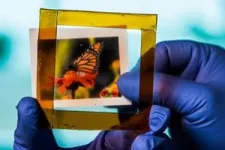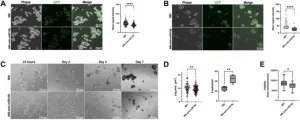(Press-News.org) HOUSTON – (Aug. 28, 2024) – Rice University researchers have developed a smart material that adjusts its transparency with changes in temperature, outperforming similar materials in terms of durability, transparency and responsiveness. The new polymer blend could significantly enhance energy efficiency for indoor space cooling, according to a new study published in Joule.
Cooling off can be a matter of life or death, but air conditioning ⎯ when and if available ⎯ already accounts for 7% of the world’s energy use and 3% of carbon emissions. With temperatures hitting record highs and heat waves growing more frequent worldwide, the need for more efficient ways to keep indoor temperatures in check has also grown more urgent.
One way to mitigate the issue involves coating windows with materials that keep heat out while still allowing light to pass through. One such class of materials is thermochromics, yet existing varieties are still too expensive and short-lived to make a feasible choice for use in buildings, vehicles and wherever else needed.
The new salted polymer blend system developed by Rice engineers in the Nanomaterials Laboratory led by Pulickel Ajayan overcomes these challenges, potentially enabling the large-scale deployment of thermochromics as an energy-efficient indoor space cooling technology.
“Imagine a window that becomes less transparent as the day gets warmer, keeping interiors cool without consuming energy,” said Sreehari Saju, a materials science and nanoengineering doctoral student at Rice who is a co-lead author on the study. “Our formulation leverages both organic and inorganic components to overcome the limitations of existing thermochromic materials such as short lifespans and high costs.
“Moreover, this material’s thermic response is well-matched to real-world environmental demands. We think that smart windows made from this material could significantly reduce energy consumption in buildings, making a tangible impact on both energy costs and carbon footprint.”
The researchers combined experimental methods with computational simulations to understand the material’s behavior under different environmental and architectural settings. For instance, they assessed how the material would perform in specific urban areas around the world to get a sense of its potential impact when deployed at scale.
“Our approach was unique because it required a precise balance of materials and techniques that had not been previously explored in this combination, offering a new pathway for developing smart materials,” said Anand Puthirath, a research scientist in the Ajayan research group and co-lead author on the study. “We conducted comprehensive experiments to characterize the properties of the material, as well environmental stability and durability testing, showing that our blend can outperform existing thermochromics.”
The researchers synthesized the material by mixing two polymers with a type of salt and worked on optimizing the composition to achieve smooth transitions between transparent and opaque states with temperature fluctuations. Their findings show that the new thermochromic blend is not only highly effective in regulating solar radiation but also remarkably durable with an estimated lifespan of 60 years.
“These research findings set new benchmarks in thermochromics’ durability and performance and particularly in a simple practically viable system,” said Ajayan, the corresponding author on the study and Rice’s Benjamin M. and Mary Greenwood Anderson Professor of Engineering and professor and department chair of materials science and nanoengineering. “Our work addresses a critical challenge in sustainable architecture, offering a practical and scalable solution for enhancing energy efficiency in buildings.”
The thermochromic behavior of the material was studied in collaboration with Professor Yi Long and her doctoral student, Shancheng Wang, from the Department of Electronic Engineering at the Chinese University of Hong Kong, Sha Tin.
The research was supported by the Science and Engineering Research Board, India; the Air Force Office of Scientific Research (FA9550-20RXCOR057); the Robert A. Welch Foundation (C-1509); the Global STEM Professorship Scheme sponsored by the Government of the Hong Kong Special Administrative Region; and the Chinese University of Hong Kong Startup Fund. The content in this press release is solely the responsibility of the authors and does not necessarily represent the official views of the supporting entities.
-30-
This news release can be found online at news.rice.edu.
Follow Rice News and Media Relations via Twitter @RiceUNews.
Peer-reviewed paper:
“Thermochromic polymer blends” | Joule | DOI: 10.1016/j.joule.2024.07.020
Authors: Sreehari Saju, Anand Puthirath, Shancheng Wang, Thierry Tsafack, Lucas K. Beagle, Andrey Baydin, Nithya Chakingal, Natsumi Komatsu, Fuyang Tay, Arvin Sharma, Rohini Sreenivasan, Junichiro Kono, Robert Vajtai, Nicholas Glavin, Yi Long and Pulickel Ajayan
https://www.sciencedirect.com/science/article/pii/S2542435124003490?via%3Dihub
Video is available at:
https://youtu.be/c0XtnZnjS60 (Video by Brandon Martin/Rice University)
Image downloads:
https://drive.google.com/drive/folders/1_BlKV8itN_C42jZ6i7_EnU7-Ua9zAVCJ?usp=sharing
About Rice:
Located on a 300-acre forested campus in Houston, Rice University is consistently ranked among the nation’s top 20 universities by U.S. News & World Report. Rice has highly respected schools of architecture, business, continuing studies, engineering, humanities, music, natural sciences and social sciences and is home to the Baker Institute for Public Policy. With 4,574 undergraduates and 3,982 graduate students, Rice’s undergraduate student-to-faculty ratio is just under 6-to-1. Its residential college system builds close-knit communities and lifelong friendships, just one reason why Rice is ranked No. 1 for lots of race/class interaction, No. 2 for best-run colleges and No. 12 for quality of life by the Princeton Review. Rice is also rated as a best value among private universities by Kiplinger’s Personal Finance.
END
Thermochromic material could make indoor temperature control more energy-efficient
Rice engineers’ new ‘salty blend’ makes it easier to cool off
2024-08-28
ELSE PRESS RELEASES FROM THIS DATE:
Damon Runyon Cancer Research Foundation awards $4.8 million to exceptional early-career scientists
2024-08-28
The Damon Runyon Cancer Research Foundation has named 16 new Damon Runyon Fellows, exceptional postdoctoral scientists conducting basic and translational cancer research in the laboratories of leading senior investigators. This prestigious Fellowship encourages the nation's most promising young scientists to pursue careers in cancer research by providing them with independent funding ($300,000 total) to investigate cancer causes, mechanisms, therapies, and prevention.
“What is so exciting—and so challenging—about being a postdoc is that you’re called to take what you know and apply ...
Primary care providers urged to assist patients who engage in emotional eating
2024-08-28
August 28, 2024 — Primary care providers are well positioned to address emotional eating because of their long-term relationships with patients, noted Jana DeSimone Wozniak, PhD and Hsiang Huang, MD, MPH, of Harvard Medical School and Cambridge Health Alliance in Cambridge, Massachusetts. According to their article published in Harvard Review of Psychiatry, part of the Lippincott portfolio from Wolters Kluwer, emotional eating is associated with myriad health problems, including the experience of ...
Half of Uber, Lyft trips replace more sustainable options
2024-08-28
More than 50% of ride-hailing trips taken by surveyed riders in California replaced more sustainable forms of transportation — such as walking, cycling, carpooling, and public transit — or created new vehicle miles, according to a study from the University of California, Davis Institute of Transportation Studies.
The study was conducted to help guide development of the Clean Miles Standard, a state regulation designed by the California Air Resources Board to reduce the greenhouse gas emissions from ride-hailing services.
Published in Transportation Research ...
miR-10b Inhibition: A strategy for treating metastatic breast cancer
2024-08-28
“We have developed a nanodrug, termed MN-anti-miR10b, that delivers anti-miR-10b antisense oligomers to cancer cells.”
BUFFALO, NY- August 28, 2024 – A new research paper was published in Oncotarget's Volume 15 on August 26, 2024, entitled, “Inhibition of miR-10b treats metastatic breast cancer by targeting stem cell-like properties.”
As stated within the Abstract of the paper, despite advances in breast cancer screening and treatment, the prognosis for metastatic disease remains dismal, with ...
Love is blind for male fruit flies who will choose sex over safety
2024-08-28
Male fruit flies will become oblivious to physical danger as they become more engaged in courtship and sex, new research shows.
Researchers at the University of Birmingham have shown that pursuit of a coveted reward – in this case a female fly – will cause a male fruit fly to ignore threats such as predation.
In the study, published today (28 Aug) in Nature, the team was able to show for the first time the neural networks in the fly’s brain that direct this decision-making process, revealing the neurotransmitter dopamine has a leading role to play.
Lead researcher Dr Carolina Rezaval said: “Every day we make decisions that require us to ...
Kidney donors’ risk of death at all-time low
2024-08-28
The risk of death for people who donate a kidney for transplantation — already small a decade ago — has dropped by more than half since then, a new study shows.
Each year, roughly 6,000 Americans volunteer to donate a kidney, according to the Organ Procurement and Transplantation Network. Before undergoing the procedure, donors are informed of the potential risks, including death. Based on data from 1995 through 2009, experts had originally predicted that about three of every 10,000 donors were likely to die within three months of the procedure. The authors of the ...
Thirty-year trends in perioperative mortality risk for living kidney donors
2024-08-28
About The Study: Perioperative mortality after living donation declined substantially in the past decade compared with prior decades, to fewer than 1 event per 10,000 donations. Risk was higher for male donors and donors with a history of hypertension. Current guidelines for donor informed consent, based on 2009 data, should be updated to reflect this information.
Corresponding Author: To contact the corresponding author, Dorry L. Segev, MD, PhD, email dorry.segev@nyulangone.org.
To access the embargoed study: Visit our For The Media website at this link https://media.jamanetwork.com/
(doi:10.1001/jama.2024.14527)
Editor’s Note: Please ...
Intersection of poverty and rurality for early-onset colorectal cancer survival
2024-08-28
About The Study: Patients with early-onset colorectal cancer (defined as colorectal cancer diagnosed in individuals younger than 50 years) living in rural areas had lower 5-year survival rates than their urban dwelling counterparts in this study. While it was not observed consistently for all age groups, persistent poverty in these rural areas may compound this association.
Corresponding Author: To contact the corresponding author, Meng-Han Tsai, PhD, metsai@augusta.edu.
To access the embargoed study: Visit our For The Media website at this link https://media.jamanetwork.com/
(doi:10.1001/jamanetworkopen.2024.30615)
Editor’s Note: Please ...
First-generation antihistamines and seizures in young children
2024-08-28
About The Study: Prescriptions for first-generation antihistamines were associated with a 22.0% higher seizure risk in children, especially in those ages 6 to 24 months in this cohort study. These findings emphasize the need for careful and judicious prescription of first-generation antihistamines in young children and underline the need for further research to elucidate associations between antihistamine prescriptions and seizure risk.
Corresponding Authors: To contact the corresponding authors, email Seonkyeong Rhie, MD, (starclusters@gmail.com) and Man Yong Han, MD, (drmesh@gmail.com).
To ...
Prioritizing the unexpected: New brain mechanism uncovered
2024-08-28
Researchers have discovered how two brain areas, neocortex and thalamus, work together to detect discrepancies between what animals expect from their environment and actual events. These prediction errors are implemented by selective boosting of unexpected sensory information. These findings enhance our understanding of predictive processing in the brain and could offer insights into how brain circuits are altered in autism spectrum disorders (ASDs) and schizophrenia spectrum disorders (SSDs).
The research, published today in Nature, outlines how scientists at the Sainsbury Wellcome Centre at UCL studied mice in a virtual reality ...
LAST 30 PRESS RELEASES:
Tracing the quick synthesis of an industrially important catalyst
New software sheds light on cancer’s hidden genetic networks
UT Health San Antonio awarded $3 million in CPRIT grants to bolster cancer research and prevention efforts in South Texas
Third symposium spotlights global challenge of new contaminants in China’s fight against pollution
From straw to soil harmony: International team reveals how biochar supercharges carbon-smart farming
Myeloma: How AI is redrawing the map of cancer care
Manhattan E. Charurat, Ph.D., MHS invested as the Homer and Martha Gudelsky Distinguished Professor in Medicine at the University of Maryland School of Medicine
Insilico Medicine’s Pharma.AI Q4 Winter Launch Recap: Revolutionizing drug discovery with cutting-edge AI innovations, accelerating the path to pharmaceutical superintelligence
Nanoplastics have diet-dependent impacts on digestive system health
Brain neuron death occurs throughout life and increases with age, a natural human protein drug may halt neuron death in Alzheimer’s disease
SPIE and CLP announce the recipients of the 2025 Advanced Photonics Young Innovator Award
Lessons from the Caldor Fire’s Christmas Valley ‘Miracle’
Ant societies rose by trading individual protection for collective power
Research reveals how ancient viral DNA shapes early embryonic development
A molecular gatekeeper that controls protein synthesis
New ‘cloaking device’ concept to shield sensitive tech from magnetic fields
Researchers show impact of mountain building and climate change on alpine biodiversity
Study models the transition from Neanderthals to modern humans in Europe
University of Phoenix College of Doctoral Studies releases white paper on AI-driven skilling to reduce burnout and restore worker autonomy
AIs fail at the game of visual “telephone”
The levers for a sustainable food system
Potential changes in US homelessness by ending federal support for housing first programs
Vulnerability of large language models to prompt injection when providing medical advice
Researchers develop new system for high-energy-density, long-life, multi-electron transfer bromine-based flow batteries
Ending federal support for housing first programs could increase U.S. homelessness by 5% in one year, new JAMA study finds
New research uncovers molecular ‘safety switch’ shielding cancers from immune attack
Bacteria resisting viral infection can still sink carbon to ocean floor
Younger biological age may increase depression risk in older women during COVID-19
Bharat Innovates 2026 National Basecamp Showcases India’s Most Promising Deep-Tech Ventures
Here’s what determines whether your income level rises or falls
[Press-News.org] Thermochromic material could make indoor temperature control more energy-efficientRice engineers’ new ‘salty blend’ makes it easier to cool off






